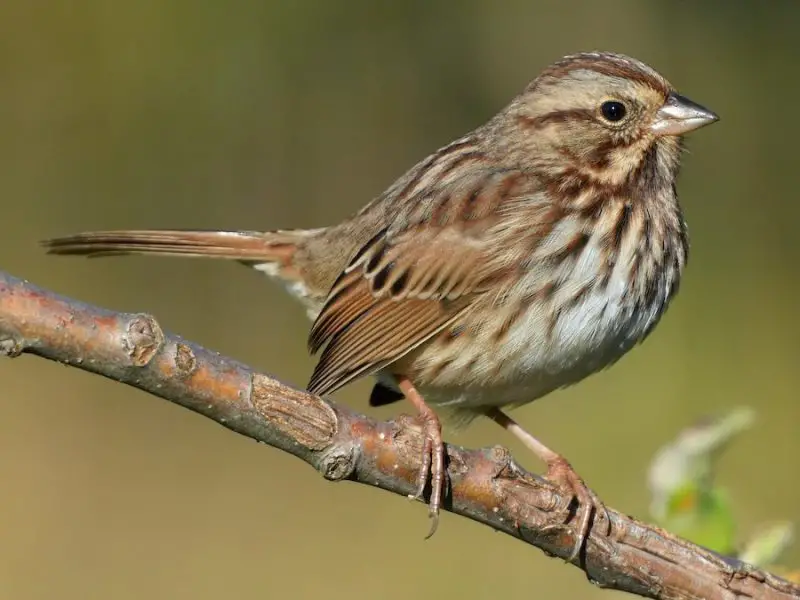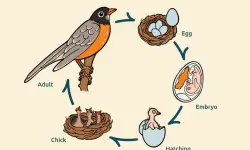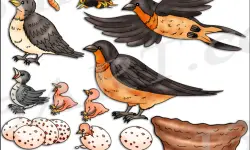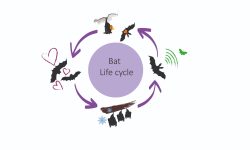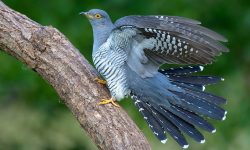Ohio’s cold months may feel hushed and still, but for birdwatchers, winter unveils a special opportunity to observe some of the hardiest and most captivating sparrows. These small songbirds bring energy and life to even the snowiest landscapes, flitting through frosted branches and foraging beneath backyard feeders. From lively suburban gardens to quiet, wooded edges, Ohio offers a winter refuge to several resilient sparrow species. In this article, we’ll meet nine beautiful sparrows that not only survive the cold—but bring it to life.
1. Dark-eyed Junco (Junco hyemalis)
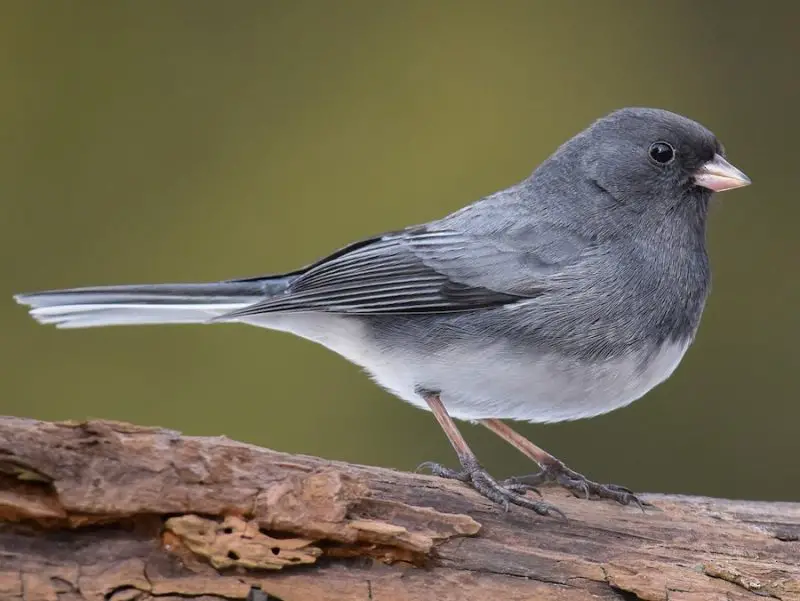
Where to Find Them
Dark-eyed Juncos are arguably the most recognizable winter sparrows in Ohio, earning them the nickname “snowbirds.” As temperatures drop in late fall, large numbers migrate south from their boreal breeding grounds in Canada and the Upper Midwest. In Ohio, they’re frequently seen flitting through open woodlands, the edges of coniferous forests, weedy fields, and suburban parks. Backyard bird feeders surrounded by shrubs or hedgerows are particularly favored, especially when snow covers natural food sources.
Identification
Dark-eyed Juncos are small, plump sparrows with a distinctive color pattern that varies slightly by region, though the “slate-colored” morph is most common in Ohio. These birds feature smooth, charcoal-gray hoods and upperparts contrasting sharply with their clean white underbellies. Their short, pink bills and conspicuous white outer tail feathers—especially noticeable in flight—make them easy to identify even at a glance. Males tend to have darker plumage, while females often appear paler or browner overall.
Winter Behavior
During Ohio’s winter, Juncos form loose, hierarchical flocks known as “winter feeding flocks,” which may include mixed species such as sparrows and chickadees. These flocks forage mostly on the ground, employing a hopping-and-scratch technique to uncover seeds beneath leaves or snow. Juncos have a strong preference for small seeds like millet, but also feed on weed seeds, grass seeds, and spilled grain in agricultural areas.
Their presence is often accompanied by a soft, musical trill or short “tik” calls used to stay in contact within the flock. As daylight hours lengthen near the end of winter, males begin to sing more frequently—an early herald of spring. Despite their small size, these sparrows are incredibly cold-hardy, relying on fat reserves and metabolic adaptations to survive frigid nights.
If you spot one beneath your feeder, take a moment to appreciate its resilience; the Dark-eyed Junco thrives where others flee, bringing quiet energy to Ohio’s winter months.
2. American Tree Sparrow (Spizelloides arborea)
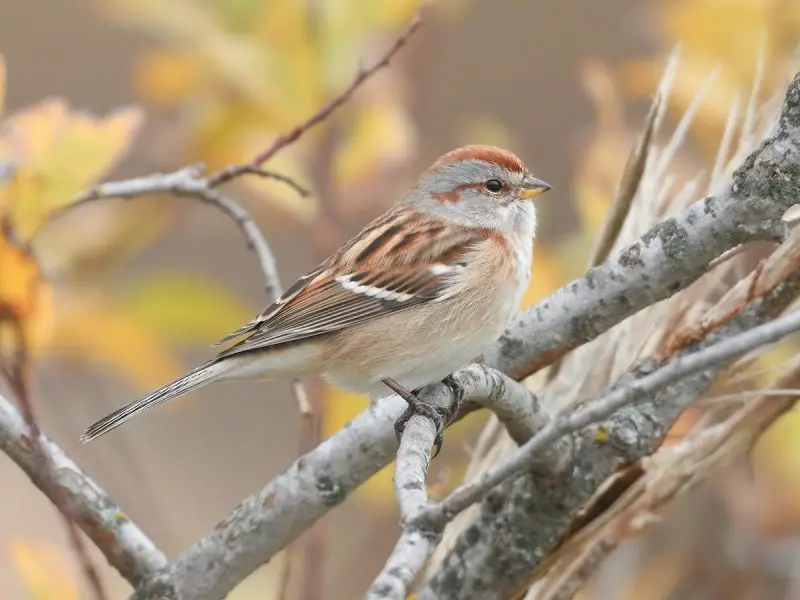
Where to Find Them
Despite their name, American Tree Sparrows are more often found in open, treeless habitats during winter. In Ohio, they frequent brushy fields, overgrown pastures, weedy fencerows, and suburban backyards with native vegetation or feeder setups. These sparrows avoid dense forests, preferring landscapes where they can forage near the ground and take quick cover in shrubs when threatened. Their distribution throughout the state expands in particularly cold winters, especially where seed-rich weeds and grasses remain standing.
Identification
The American Tree Sparrow is a medium-sized sparrow, slightly larger and bulkier than the familiar Chipping Sparrow. It’s distinguished by a bright rufous crown, a pale gray face with a rusty eye line, and a small dark spot centered on the breast—a helpful field mark in snowy settings. Its wings and back are streaked with warm browns, and the tail is long and notched. Another key feature is the bi-colored bill—dark upper mandible and yellow lower mandible—which sets it apart from similar species. Their posture often appears upright and alert, with subtle flicks of the tail and a characteristic “bouncy” foraging movement.
Winter Behavior
American Tree Sparrows breed in the Arctic tundra and northern boreal zones, far beyond the tree line, and migrate south to Ohio and the Midwest for the winter. Their arrival typically begins in late October, and they remain until early spring, departing by April as they return to their remote breeding territories.
In Ohio, they often travel and forage in loose flocks, sometimes mixed with juncos or other sparrows. They feed primarily on seeds of grasses, goldenrods, and forbs, but will also consume small berries and insects when available. Their foraging is low to the ground—on snow, soil, or beneath weedy cover—using a rapid hop-scratch behavior to uncover food. When snow is deep, they often visit bird feeders, favoring millet, sunflower chips, and nyjer seed.
Social and vocal, these sparrows communicate with clear, musical whistles and soft “tseeet” calls. On warmer winter days, males may even sing—a delicate, tinkling tune that hints at their far northern summer homes. Their presence during Ohio’s coldest months adds both motion and melody to otherwise frozen landscapes.
4. White-throated Sparrow (Zonotrichia albicollis)
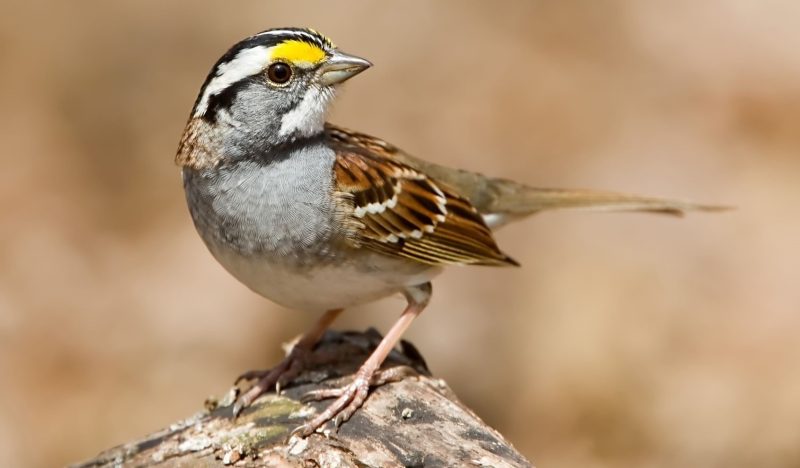
Where to Find Them
White-throated Sparrows are regular and widespread winter visitors across Ohio, occupying a variety of habitats that provide dense cover and open ground for foraging. They are commonly found in deciduous woodlands, forest edges, overgrown thickets, and brushy suburban backyards. Their preference for layered vegetation—low shrubs beneath taller trees—makes hedgerows, wooded trails, and landscaped gardens ideal winter habitat.
Identification
White-throated Sparrows are elegant, medium-sized sparrows known for their crisp white throat patch, which contrasts with a grayish breast and brown-streaked back. Two distinct head stripe morphs exist: the white-striped morph features bold black-and-white crown stripes, while the tan-striped morph displays softer tan and brown head stripes. Both morphs have a splash of yellow between the eye and the bill—called the lores—which adds a distinctive flash of color to their facial pattern.
Their stout, conical bill and long tail make them well adapted for ground foraging, and they typically exhibit a confident, slow, hopping gait as they search for food beneath dense brush.
Winter Behavior
White-throated Sparrows breed in Canada and the northern U.S., but migrate southward into Ohio for the winter, typically arriving in October and staying through early May. During the colder months, they form small, loose flocks that forage primarily on the ground, scratching through leaf litter, snow, or soil in search of seeds, grains, and the occasional dormant insect or spider.
They’re frequent visitors to backyard feeders, especially when seed is scattered on the ground or offered on low platforms. Black oil sunflower seed, millet, and cracked corn are particularly attractive to them, especially if dense vegetation is nearby to provide quick cover from predators.
These sparrows are also vocal during winter, often giving a high-pitched “tseeet” contact call as they move through underbrush. Occasionally, on mild days, males may sing fragments of their famous song—a slow, whistled “Oh-sweet-Canada-Canada”—which can be hauntingly beautiful when heard echoing through a quiet winter forest.
The White-throated Sparrow brings both color and sound to Ohio’s subdued winter landscapes, and its distinctive appearance makes it a favorite among backyard birders and woodland walkers alike.
5. White-crowned Sparrow (Zonotrichia leucophrys)
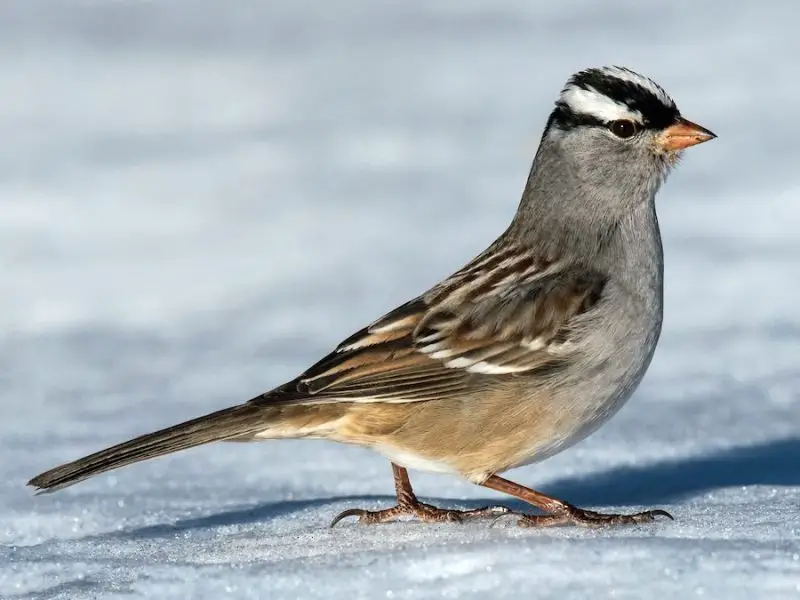
Where to Find Them
White-crowned Sparrows are best known as long-distance migrants, passing through Ohio in large numbers during spring and fall. However, a small but reliable wintering population persists in southern parts of the state, especially in brushy fields, hedgerows, woodland edges, and overgrown roadsides. These sparrows favor open habitats with ample cover, where they can move easily between foraging grounds and protective thickets.
Identification
Few sparrows are as visually striking as the adult White-crowned Sparrow. Its bold black-and-white striped crown, soft gray face and breast, and pink or orange conical bill give it a crisp, clean appearance that stands out even in muted winter light. Its back and wings are streaked brown, and its long tail is often carried straight. Juveniles, often seen in late fall and early winter, have brown and tan crown stripes instead of black and white but retain the same overall structure and body shape.
Their upright posture, confident ground movements, and distinctive head pattern make them easy to pick out in mixed flocks or among leaf litter.
Winter Behavior
White-crowned Sparrows migrate from their breeding grounds in Alaska, Canada, and the western U.S., arriving in southern Ohio in late fall. Though they are more numerous during migration, winter residents can be found foraging in low vegetation, often scratching through grasses and debris to uncover seeds, weed grains, and small fruits. They occasionally visit feeders, particularly if millet or cracked corn is scattered on the ground near cover.
Social by nature, these sparrows may gather in small flocks and are often seen alongside White-throated or Song Sparrows. Their vocalizations are soft and pleasant—gentle whistled notes and trills used to maintain contact within flocks or assert dominance in feeding areas. Males rarely sing full songs during winter, but fragments may be heard on warmer days.
Despite their limited winter range in Ohio, spotting a White-crowned Sparrow amid snow-dusted shrubs is a treat for any cold-season birder. Their bold markings and composed behavior offer a beautiful contrast to the season’s stark simplicity, making them a standout among winter’s quieter sparrow cast.
6. Fox Sparrow (Passerella iliaca)
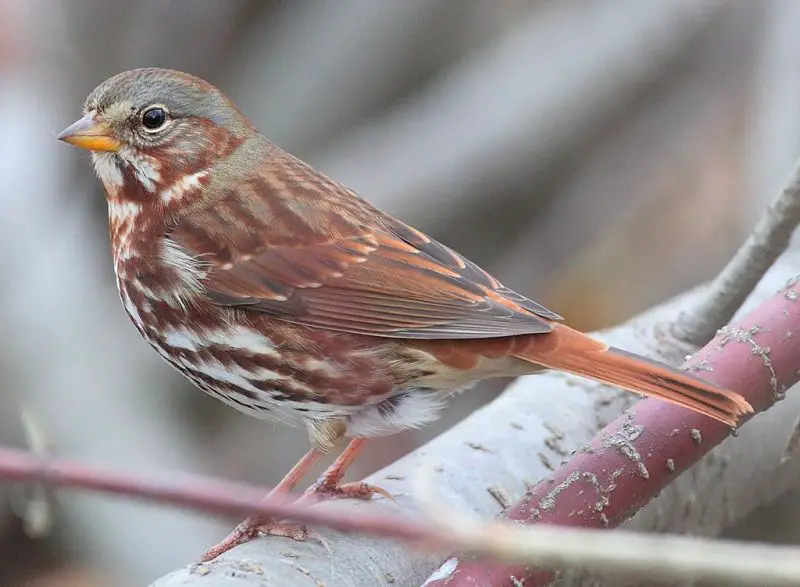
Where to Find Them
Fox Sparrows are rare but regular winter visitors in Ohio, most commonly encountered in the southern half of the state during particularly mild or favorable winters. They favor dense thickets, overgrown hedgerows, brushy woodland edges, and ravines rich in leaf litter and understory growth. Their secretive habits and preference for low, tangled cover make them easy to overlook, but patient birders can spot them in quiet, brush-laden habitats.
Identification
Fox Sparrows are among the largest and most powerfully built of North America’s sparrows. They are immediately recognizable by their rich rufous coloration, especially in the eastern subspecies most likely to appear in Ohio (the “Red” Fox Sparrow). Their backs, wings, and tail are a deep, rusty brown, while the underparts are heavily streaked with chevron-shaped reddish marks that often converge into a central breast blotch.
Their large, rounded body, thick neck, strong conical bill, and slightly hunched posture give them a thrush-like silhouette, and their plumage seems to glow with warmth in the cold, wintry light.
Winter Behavior
Fox Sparrows breed in boreal forests and mountain thickets of Canada and the northern U.S., migrating through Ohio during spring and fall. A small number overwinter in the state, particularly in sheltered, undisturbed habitats where food and cover are abundant.
They are ground foragers by nature, and one of their most distinctive behaviors is a vigorous double-scratch motion with both feet to expose seeds and insects beneath leaf litter or snow. This foraging style is often noisy and can help birders locate them by sound before sight. Their diet in winter consists mostly of seeds, berries, and any remaining arthropods.
Fox Sparrows are shy and solitary in winter, rarely joining mixed flocks and usually retreating quickly into dense vegetation when disturbed. They may visit backyard feeding areas if brush piles and natural cover are nearby, especially when seed is scattered directly on the ground.
While elusive, a glimpse of a Fox Sparrow—its warm plumage vivid against the snow—is a highlight of any winter birding day. Its presence in Ohio’s colder months is a quiet reminder of the boreal wilderness to the north and the resilience of wildlife that endures across seasonal extremes.
7. Swamp Sparrow (Melospiza georgiana)
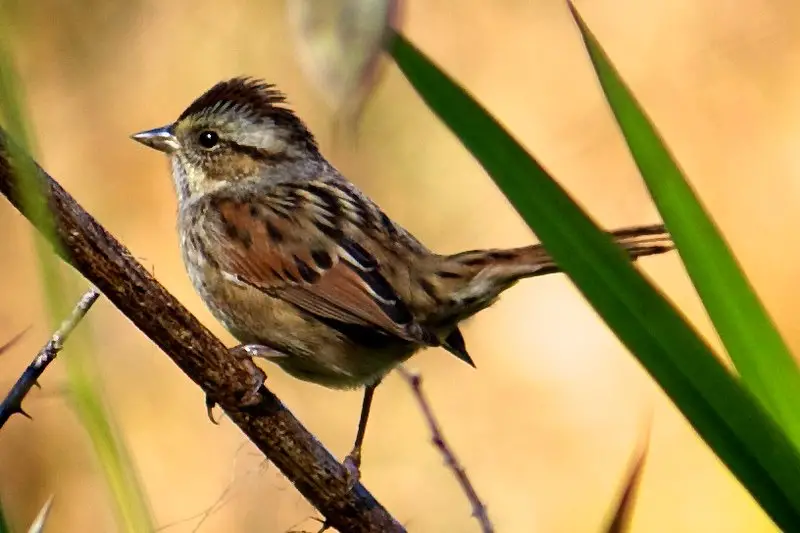
Where to Find Them
While many Swamp Sparrows migrate farther south for winter, a modest overwintering population remains in Ohio, particularly in the southern and central regions of the state. These birds are habitat specialists, favoring wetlands, sedge meadows, cattail marshes, and wet thickets that retain standing water and protective vegetation through the colder months. Areas with dense, tangled vegetation near streams or floodplains provide essential shelter and food sources during winter.
Identification
Swamp Sparrows are subtly striking, with a combination of rich, rusty wings, a smooth gray face, and a black-streaked crown that creates a distinctive yet understated appearance. Their underparts are a dull grayish-white, and the flanks may show a warm wash of rufous. Though similar in build to Song Sparrows, they appear slightly more refined, with a sleeker profile and less streaking on the breast.
Their coloration helps them blend into the browned-out vegetation of winter wetlands, making them challenging to spot unless you’re patient or lucky enough to catch them foraging along the edges of frozen marshes.
Winter Behavior
Swamp Sparrows are naturally secretive, and in winter, their behavior becomes even more reclusive. They remain low to the ground, often within dense reeds or brush piles, moving cautiously and quietly as they forage for seeds of sedges, grasses, and aquatic plants. Unlike many sparrows, they rarely visit feeders, though they may appear in brushy backyard habitats—especially those adjacent to damp or marshy ground.
They are adept at surviving cold wet environments, relying on dense cover for insulation and protection. Even during freezing conditions, Swamp Sparrows may remain in partially thawed wetland edges where microhabitats offer warmth and food. Their calls in winter are infrequent—usually a soft “chip”—though occasional vocalizations may help individuals stay in contact within sparse winter populations.
For dedicated birders, glimpsing a Swamp Sparrow in Ohio during winter is a rewarding experience. Their presence adds another layer of richness to wetland ecosystems and demonstrates the remarkable diversity of sparrow species that endure Ohio’s varied and often challenging winter landscape.
8. Savannah Sparrow (Passerculus sandwichensis)
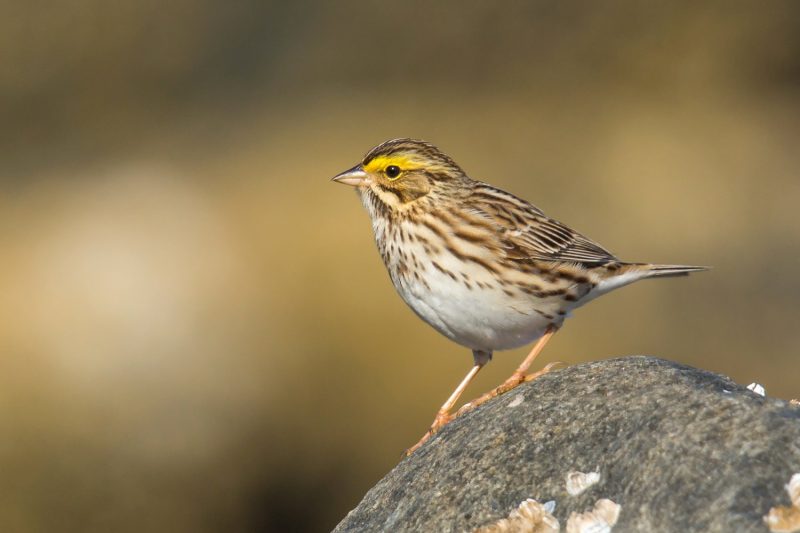
Where to Find Them
Though the majority of Savannah Sparrows migrate to the southern United States or Mexico for the winter, a small overwintering population persists in southern Ohio, particularly in open grasslands, hayfields, agricultural stubble, and prairie remnants. These birds favor expansive, low vegetation where they can remain concealed while foraging, and they avoid heavily wooded areas or urban landscapes.
Winter sightings are rare but possible in unplowed farm fields, conservation grasslands, or restored prairie patches, especially those with standing grasses or seed-rich weeds.
Identification
Savannah Sparrows are small, finely marked birds with a streaked brown back, pale underparts with crisp brown streaks, and a distinctive yellow wash in the lores—the area just in front of the eye. This yellow tinge can be subtle but is a key field mark when viewed in good light. They have a short, notched tail, a relatively flat head, and a small, pinkish bill.
Their appearance can resemble that of Song Sparrows or other streaked species, but their smaller size, cleaner streaking, and yellow lores help set them apart. Subtle regional variations in plumage may occur, with paler individuals more common in the wintering range.
Winter Behavior
Savannah Sparrows are ground-dwelling specialists, adapted to life in shortgrass environments. During winter in Ohio, they remain close to the ground, weaving through dry grasses and low weed stems as they forage for seeds from native forbs and agricultural crops. They tend to avoid human disturbance and will flush low and quickly if approached, often dropping back down into cover a short distance away.
Unlike more feeder-friendly sparrows, Savannah Sparrows rarely visit backyard feeding stations, preferring natural seed sources in undisturbed open areas. They are highly camouflaged, making detection a true challenge—especially in wind-swept, beige-toned fields where their plumage blends perfectly into the winter landscape.
Their calls in winter are soft and high-pitched, often going unnoticed unless you’re listening carefully. Sightings of Savannah Sparrows in Ohio’s cold season are modest in number, but for sharp-eyed birders willing to brave the cold and scan quiet fields, spotting one can be a truly satisfying reward.
Their continued presence in Ohio’s winter prairies reflects the importance of maintaining open grassland habitats—not just for breeding birds in summer, but for these hardy winter holdouts as well.
9. Field Sparrow (Spizella pusilla)
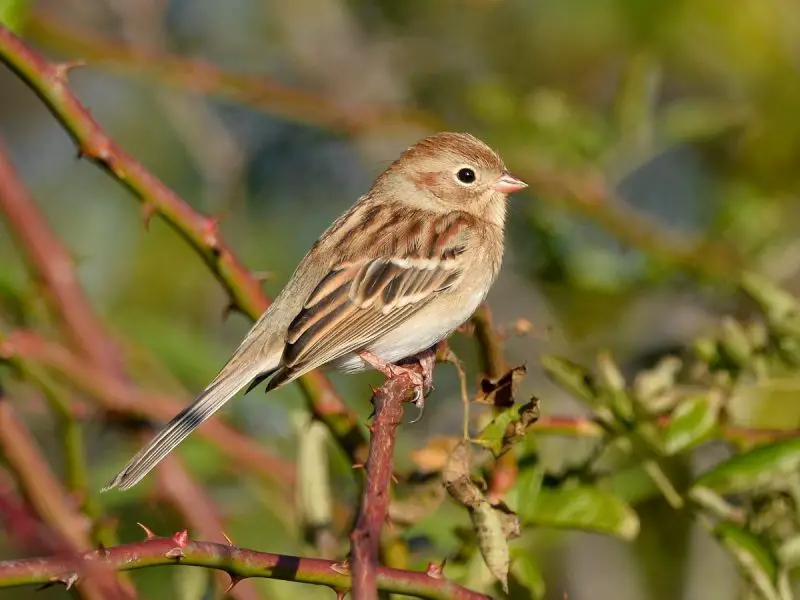
Where to Find Them
Unlike many sparrows that migrate south for winter, Field Sparrows are year-round residents across much of Ohio. While widespread in summer, their winter presence is more localized and elusive, with individuals concentrating in shrubby old fields, regenerating clear-cuts, forest edges, and overgrown lots. These habitats provide the dense, low cover needed for protection against harsh weather and predators. They are rarely found in urban areas during winter but may appear at the edges of rural yards if suitable cover and food are available.
Identification
Field Sparrows are small, delicate-looking sparrows with a clean, plain facial appearance. Key features include a pink conical bill, gray face, warm rufous crown and back, and unstreaked white underparts—all of which give them a soft, almost gentle appearance compared to their heavily streaked cousins. Their eyes appear large and dark, enhancing their expressive look. While subtle in coloration, they are easy to distinguish with a bit of practice due to their overall clean and warm-toned plumage.
Their famous melodic trill, reminiscent of a bouncing ping-pong ball, is commonly heard in spring and summer, but during winter, Field Sparrows become nearly silent, relying instead on quiet chip calls for communication within small flocks.
Winter Behavior
As temperatures drop, Field Sparrows abandon their summer territories and adopt a more nomadic lifestyle, foraging in small groups and sticking closely to brush piles, briar tangles, and weedy thickets. Their winter diet consists largely of grass and weed seeds, often gathered directly from the ground or low stems. They forage methodically, using short hops and pauses to locate food, often within inches of cover.
These sparrows do not typically visit feeders unless natural food sources are scarce and brushy shelter is nearby. Homeowners who maintain native grass borders, wildflower meadows, or allow parts of their property to grow wild and brushy are far more likely to attract them during winter.
The Field Sparrow’s ability to endure Ohio’s coldest months without migrating highlights its strong ecological connection to early successional habitats. As such habitats become increasingly rare due to development and land-use changes, preserving and restoring them is vital—not only for breeding season success, but for the survival of these quietly persistent winter residents.
Spotting a Field Sparrow on a frosty morning—its soft colors glowing in the winter light—is a quiet reminder of the resilience and understated beauty that defines Ohio’s winter birdlife.
How to Attract Winter Sparrows to Your Ohio Backyard
Ohio’s winter sparrows are resilient, but even the hardiest birds need reliable food, shelter, and water when snow blankets the landscape. With a little planning, your backyard can become a welcoming haven for these cold-season songbirds.
Offer the Right Food
Most winter sparrows are ground foragers, evolved to search for fallen seeds rather than perch on hanging feeders. To attract them, scatter food directly on the ground, on a low platform feeder, or beneath shrubs where birds feel safer from predators.
Ideal food choices include:
-
White millet – a favorite of juncos, tree sparrows, and field sparrows.
-
Black oil sunflower seeds – rich in calories and highly preferred by many sparrow species.
-
Cracked corn – provides bulk energy, especially attractive to White-throated and Fox Sparrows.
Keeping feeding areas sheltered from wind and close to dense vegetation increases the likelihood that wary species will visit.
Provide Shelter
In winter, cover is just as important as food. Sparrows rely on dense shrubs, evergreens, tall grasses, and brush piles to protect them from icy winds and predators like hawks or neighborhood cats. Native shrubs like dogwood, viburnum, or wild plum are ideal, especially if they also offer berries or seeds.
Creating a brush pile from trimmed branches and yard debris not only recycles natural material but provides excellent shelter. Position it near feeders to give sparrows quick access to cover.
Keep Water Available
Water is often the most overlooked necessity in winter birdscaping. When temperatures drop below freezing, natural water sources freeze, forcing birds to travel far or go without. A heated birdbath ensures a consistent supply of liquid water, drawing in sparrows and other species that might otherwise pass by your yard.
Place the birdbath in a safe, open area with nearby cover, and keep it clean to prevent the spread of disease. You’ll be surprised how often sparrows will visit—even on the coldest days—to drink and occasionally bathe.
Final Thoughts
Ohio’s winter may seem still and silent at first glance, but a closer look reveals a world full of feathered life. These nine sparrows not only survive the season—they enrich it with motion, resilience, and subtle beauty. From snowy fields to quiet backyard corners, their presence is a reminder that nature endures even in the coldest months. By observing and learning about these winter visitors, bird enthusiasts can find inspiration, deepen their appreciation for Ohio’s year-round wildlife, and bring the quiet magic of winter sparrows into their daily lives.

